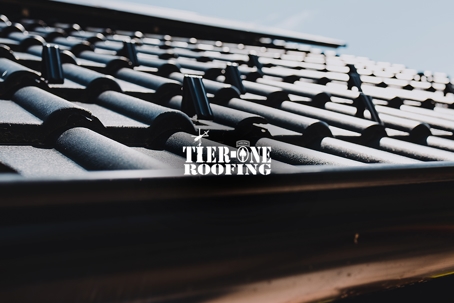The Most Overlooked Roof Repairs After a Hailstorm (Until It’s Too Late)
When a hailstorm rolls through Oklahoma, most homeowners look out the window, check their cars, and glance at the yard. Maybe they walk out to the driveway, look up at the roof and think, “Looks fine to me.”
But here’s the truth: most serious hail damage isn’t visible from the ground. And by the time you see a ceiling stain or find a shingle in your yard, it’s too late to prevent real damage.
At Tier-One Roofing, we’ve seen it all—roofs that looked perfectly fine after a storm but ended up leaking three months later. Homeowners who waited too long and got denied by insurance. And plenty of small, avoidable issues that turned into major expenses.
If you want to avoid that? Keep reading.
What Hail Actually Does to a Roof
Hail doesn’t have to break windows or leave massive dents to cause serious damage. Here’s how it silently wrecks your roof:
Granule loss – Hail knocks off the protective coating that guards against UV rays.
Micro-cracks – These hairline fractures in shingles can’t be seen from the ground but let water seep in.
Bruising – The impact softens shingles, reducing their effectiveness over time.
Damaged flashing and vents – Hail can dent and unseal metalwork that protects key entry points.
Dislodged sealants – Caulking around vents, chimneys, or satellite mounts may crack from vibration.
The worst part? Insurance claims often require fast documentation. If you wait too long, they may say the damage is due to “age” or “neglect.”
Tier-One Roofing inspects roofs within 24–48 hours after hail events, so you have documentation ready before adjusters even show up.
Top 7 Overlooked Hail Repairs That Cause Big Trouble Later
These are the fixes most roofers miss—or that homeowners never think to check:
Damaged ridge caps – These high points take direct hits but aren’t visible from ground level.
Punctured or cracked pipe boots – Small hail can destroy rubber flashing around plumbing vents.
Dented gutter guards or hidden fascia – You may not see them, but they compromise runoff flow.
Lifted shingles – Even if they lay flat, impact can break the adhesive strip underneath.
Decking soft spots – Water leaks through small cracks and weakens the wood beneath.
Mastic sealant loss – Chimneys and skylights lose their waterproofing edge.
Unseen vent damage – Hail dents can warp or create gaps in attic ventilation covers.
Each of these repairs costs far less to address early—but if ignored, they lead to mold, rot, insulation failure, and full roof replacement.
Why Most Homeowners Miss These Problems
There are three big reasons these issues go undetected:
You can’t see them without getting on the roof
They often don’t cause leaks right away
Most roofers don’t check for them unless you ask
Unfortunately, this means homeowners think everything’s fine—until the warranty expires or the next storm finishes the job.
Tier-One Roofing always performs full post-hail assessments using photo documentation, drone footage, and thermal moisture scans when needed.
How to Spot Signs of Hidden Hail Damage (Even Without a Ladder)
You don’t need to climb up there to know something’s wrong. Watch for:
Shingle granules in your gutters or driveway
Dents on metal mailbox posts or AC units (same hail hit your roof)
Water spots or yellowing on ceilings
New drafts or hot/cold zones in your attic
Neighbors getting roof inspections or repairs (hail doesn’t hit one house at a time)
When in doubt, book a free inspection with Tier-One Roofing. We’ll look at your roof the way an insurance adjuster does—and help you stay ahead of it.
What Happens If You Wait Too Long to Address It
Insurance policies have time limits. Most require a claim within 12 months—or less.
If you wait:
You might have to pay out-of-pocket
You risk the claim being denied as “old damage”
Your roof may no longer be eligible for repair—only full replacement
You’ll likely spend more on energy due to ventilation or moisture issues
Even worse? Some adjusters assume damage didn’t happen during the last storm if you don’t have inspection records. That’s why documentation matters.
Tier-One not only inspects your roof—we provide a full photo report, date-stamped for insurance use, and walk you through the process with zero pressure.
Why Tier-One Roofing Finds What Others Miss
Here’s how we’re different:
Veteran-Owned Attention to Detail – We approach every roof like a mission. Miss nothing.
Trained Insurance Specialists – We know what adjusters look for and document accordingly.
Drone Inspections – For steep or multi-story homes where human eyes can’t safely reach.
Thermal Scans (Optional) – To check moisture beneath the surface where problems hide.
Post-Repair Documentation – We file final reports to prove all repairs were done correctly.
This is how we protect your investment—and your peace of mind.
What You Should Do After a Hailstorm, Step by Step
Check for obvious signs like granules, ceiling spots, and neighbor damage.
Call Tier-One Roofing within 72 hours—we prioritize storm response.
Get a documented inspection with photos, recommendations, and next steps.
File a claim (if needed) with our help—we’ll meet your adjuster on site.
Schedule repairs or replacements only if truly needed.
No pressure. Just facts. And protection before small problems become expensive.
Don’t Wait for the Leak
Most of the worst roof problems we fix were avoidable. They started with a single hailstorm, a missed crack, or a neglected inspection.
If your home has weathered a storm this year, don’t guess. Don’t assume. And don’t wait for water.
Call Tier-One Roofing. Get ahead of the damage. And protect your home like it deserves to be protected.
Free inspections
Same-day photo reports
Insurance guidance
Veteran-owned integrity
Tier-One Roofing. Built to last. Backed by people who care.

